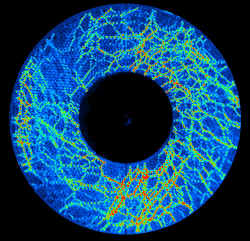Probing a Sandpile with Sound

Dunes blow in the Sahara, cereal shifts in its box, and wheat falls in a silo. Physicists have a hard time describing the complex motions of such “granular materials” because they don’t fit neatly into categories like solids or liquids. Just characterizing the state of a bag of sand is challenging without a complete picture of the widely varying forces on each grain. In the 1 March PRL a group of physicists in France demonstrates that ultrasound pulses can probe the detailed structure of a granular material. They found that sound waves that scatter many times inside a collection of beads carry information on the distribution of forces on the particles.
Xiaoping Jia and his colleagues at the University of Paris placed glass beads ranging from 0.2 to 1.5 mm in size (depending on the experiment) in 3 cm diameter cylinders. The beads were squeezed by pistons pressing with seven times atmospheric pressure. Just inside the pistons they placed an ultrasound transmitter on top of the beads and a detector underneath. When they applied 2 µs pulses to the beads, the team found that two components arrived at the detector: a well-defined short pulse–called E-pulse–that arrived in about 10 µs, and a longer, irregular S-pulse that was spread out over several hundreds of microseconds. “This has never been observed yet, although you can expect this phenomenon on theoretical grounds” because of the many sound reflections among the beads, says team member Christiane Caroli.
The frequency composition of the S-pulse is a so-called “speckle” spectrum–an apparently random distribution of narrow peaks spread over about 1 MHz in frequency. The shape of this speckle spectrum should allow materials scientists to deduce certain properties of the granular material. How to relate the speckle spectrum to the granular structure of the material still needs to be elaborated–this research is still in a preliminary stage, says Caroli. But the team has already observed clear changes in the spectrum as they increase the pressure from the pistons that squeeze the beads, and they have other experiments planned, as well. “Another thing we will test is what happens when we move one bead in a controlled fashion,” says Caroli. “We will try to obtain ‘fingerprints’ in the speckle” that represent specific changes in the granular structure.
The sound propagation in granular materials is very complicated, says Heinrich Jaeger of the University of Chicago. “These are beautiful measurements. We are now getting a more complete picture of what is going on, and this is a first step towards understanding it. But we are not done,” says Jaeger, who adds that one should also move towards larger systems that contain many more grains.
–Alexander Hellemans
Alexander Hellemans is a freelance science writer in Naples, Italy, and a contributor to the upcoming book 30-Second Quantum Theory (Icon Books, June 2014).


